#Sikorsky Seahawk
Text
youtube
#youtube#militarytraining#Sikorsky Seahawk#Navy DT#RWWS Training#Seahawk helicopter#Helicopter landing training#Helicopter crew#Navy helicopter#Helicopter pilot#Military training#Helicopter rescue#Naval aviation#Helicopter maneuvers#Helicopter landing#Helicopter training#Military helicopter#Navy pilot#Helicopter takeoff#Helicopter operations training.#Helicopter operations#Vertical landing
4 notes
·
View notes
Text
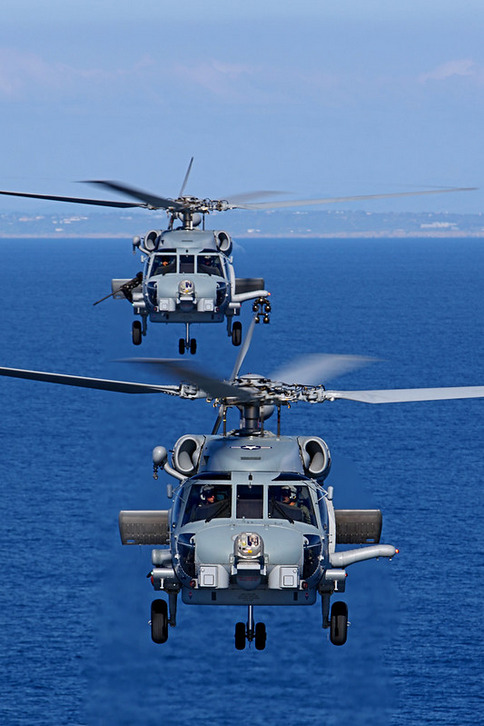
US Navy Sikorsky MH-60R Seahawks over the Pacific
221 notes
·
View notes
Text

SİKORSKY SH-60 SEAHAWK
133 notes
·
View notes
Text

A Sikorsky SH-60F Seahawk of Anti-Submarine Squadron Three (HS-3, Tridents) performs plane guard duties above USS SAN JACINTO (CG-56), which is underway on a regularly scheduled deployment conducting Maritime Security Operations (MSO) in the Red Sea.
Photographed by PHAA Nathan Laird, USN on February 13, 2006.
NARA: 6669910
#USS San Jacinto (CG-56)#USS San Jacinto#Ticonderoga Class#Guided Missile Cruiser#Cruiser#February#2006#Red Sea#Sikorsky SH-60 Seahawk#Sikorsky SH-60#SH-60 Seahawk#SH-60#Helicopter#HS-3#united states navy#us navy#navy#usn#u.s. navy#my post
54 notes
·
View notes
Photo
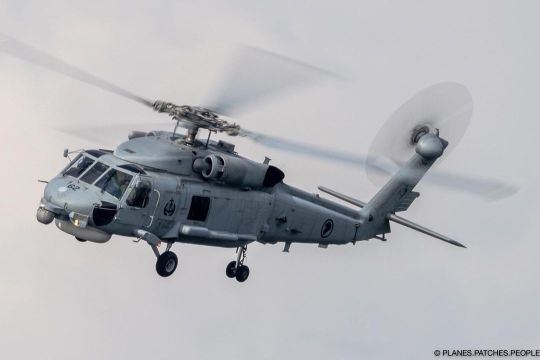
Seahawk skirting the shoreline on its return to base. #TheRSAF #AboveAll #OneSAF #AviationGeek #MilitaryAviation #MilitaryEnthusiast #aviationphotography #instagramaviation #aviation4u #excellentaviation #PlaneSpotter #PlaneSpotting #MilitaryGeek #instagood #123SQN #S70B #Seahawk #Sikorsky #SwiftandPrecise #Helicopters #Singapore #avgeek #Nikon #NikonZ9 #Nikonsg #PlanesPatchesPeople (at Singapore / Singapura / 新加坡 / சிங்கப்பூர்) https://www.instagram.com/p/CqIDpMMv09r/?igshid=NGJjMDIxMWI=
#thersaf#aboveall#onesaf#aviationgeek#militaryaviation#militaryenthusiast#aviationphotography#instagramaviation#aviation4u#excellentaviation#planespotter#planespotting#militarygeek#instagood#123sqn#s70b#seahawk#sikorsky#swiftandprecise#helicopters#singapore#avgeek#nikon#nikonz9#nikonsg#planespatchespeople
0 notes
Text

A Sikorsky HH-60H SeaHawk conducting a vertical replenishment at sea with the Ticonderoga-class cruiser USS Anzio.
164 notes
·
View notes
Text
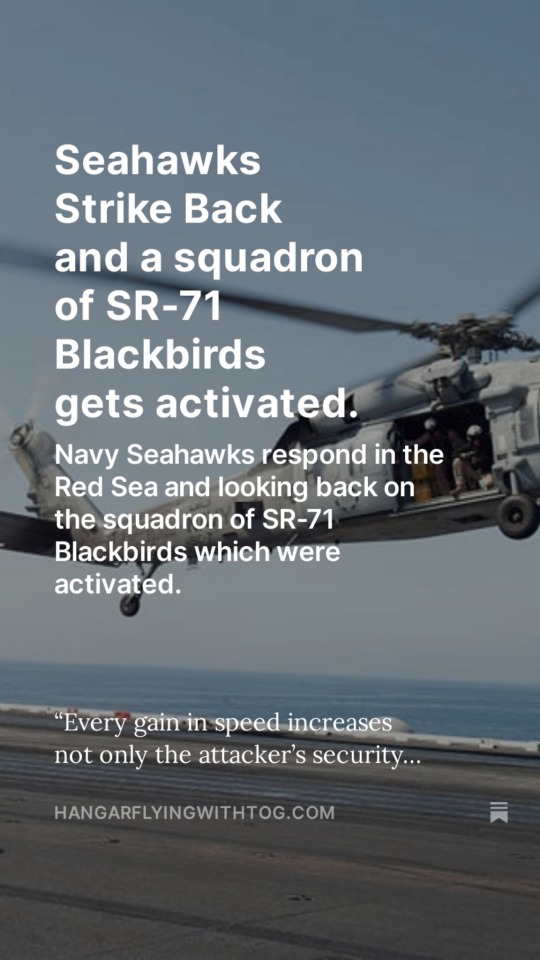
Seahawks Strike Back and a squadron of SR-71 Blackbirds gets activated.
Navy Seahawks respond in the Red Sea and looking back on the squadron of SR-71 Blackbirds which were activated.
PilotPhotog
“Every gain in speed increases not only the attacker’s security but the defender’s insecurity. For the higher the speed the greater the chance of, and scope for, surprise. Speed and surprise are not merely related; they are twins.”
-B.H. Liddell Hart
Mission Briefing
Happy New Year! 2024 is shaping up to be a significant year on many fronts, and 2023 certainly ended with a bang of sorts. Early in the morning hours of December 31st, the waters around the Arabian Peninsula were suddenly disrupted by a distress call. It's the containership Maersk Hangzhou, under siege for the second time in less than 24 hours. This time, the attackers are four small boats, manned by Iranian-backed Houthi forces, emerging from Yemeni territories under Houthi control.
The Maersk Hangzhou's crew, facing a dire situation, watched as these boats, armed with crew-served and small arms weapons, advanced and fired on the ship. These boats would get dangerously close, just 20 meters away, and even attempted to board the ship. In response, the ship's security team fights back, but the situation escalated rapidly.
Enter the heroes of our story: US Navy H60 Seahawk helicopters. These powerful machines, part of the USS Eisenhower and Gravely's compliment, fly to the rescue. They issue verbal warnings, but the small boats, undeterred, fire upon the helicopters. The Navy pilots and crew, trained for such moments, return fire in self-defense. Their precision and skill are undeniable as they sink three of the four boats and drive the fourth away. Remarkably, the US personnel and equipment remain unscathed.
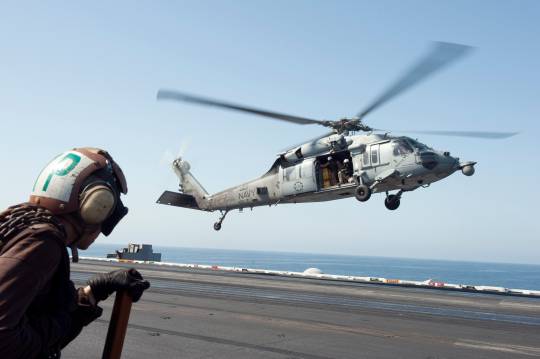
An MH-60S Seahawk helicopter of HSC-7 landing (US Navy)
The exact H60 squadrons involved remain unconfirmed by US Central Command. However, among them were likely several helicopters from HSC 7, aka the "Dusty Dogs" of Carrier Airwing 3 aboard the USS Dwight D. Eisenhower. These pilots, flying the Sierra model of the Seahawk, probably relied on the formidable .50 caliber machine gun mounted on the aircraft's starboard side.
While I normally do videos and newsletter articles about fighter planes, we need to take a moment to appreciate the Navy’s MH-60 Seahawk, which is an incredibly versatile machine and somewhat underrated. The Sikorsky SH-60/MH-60 Seahawk is a marvel of modern aviation technology. It's a twin-engine helicopter equipped with turboshaft engines, skillfully designed for multiple missions by the United States Navy. This impressive bird is derived from the U.S. Army's UH-60 Black Hawk and is part of the renowned Sikorsky S-70 family. What sets the Seahawk apart are its unique design tweaks – the main rotor blades can fold, and it has a hinged tail, making it a perfect fit for the confined spaces on ships.
In the vast blue expanses where the U.S. Navy sails, the H-60 airframe takes on various roles, embodied in the models SH-60B, SH-60F, HH-60H, MH-60R, and MH-60S. This helicopter is incredibly versatile, able to operate from virtually any air-capable naval vessel – be it a frigate, destroyer, cruiser, fast combat support ship, expeditionary transfer dock, amphibious assault ship, littoral combat ship, or even an aircraft carrier.
The Seahawk's mission profile is impressively diverse. It's a master of anti-submarine warfare (ASW) and anti-surface warfare (ASUW), making it a formidable foe against underwater and surface threats. For more covert operations, it excels in naval special warfare (NSW) insertion. In times of crisis, the Seahawk is a guardian angel, performing search and rescue (SAR) and combat search and rescue (CSAR) missions. It's also a lifeline for logistical support through vertical replenishment (VERTREP) and plays a crucial role in medical evacuations (MEDEVAC). All in all, the Sikorsky SH-60/MH-60 Seahawk is a multi-mission powerhouse, essential to the U.S. Navy's operations across the globe.
Looking ahead to 2024, given the ongoing events unfolding around the world, you can expect more mini documentaries not just on fixed wing aircraft, but helicopters like the Seahawk and other support aircraft.
This week in aviation history
1 January 1965: The Cold War is at its peak, and the United States Air Force is in dire need of a reconnaissance aircraft that can outrun and outmaneuver any threat. Enter the SR-71A, a marvel of engineering, capable of flying at speeds over Mach 3 and at altitudes above 85,000 feet.
On New Year’s Day in 1965, a significant day at Beale Air Force Base in California. On this day, the 4200th Strategic Reconnaissance Wing was activated, specifically to operate this groundbreaking aircraft. The SR-71A wasn't just a plane; it was a statement of technological prowess, capable of gathering crucial intelligence while remaining virtually untouchable by enemy defenses.
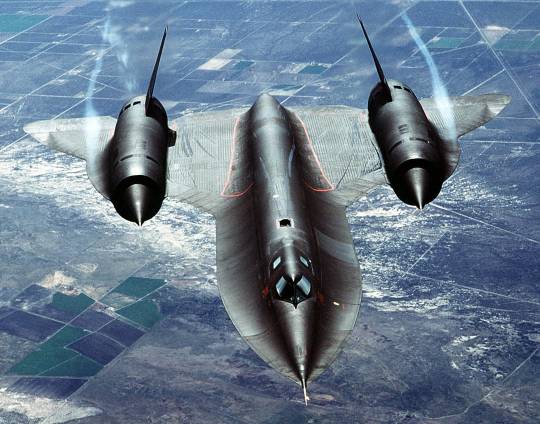
An SR-71 in flight. Note the water vapor plumes (USAF)
The wing's mission was clear: strategic reconnaissance, a vital component in the high-stakes game of the Cold War. The SR-71A's capabilities were unprecedented. It could cover vast distances incredibly fast, capturing detailed photographs of enemy territories without being detected or intercepted. This wing, with its Blackbirds, was a key player in the strategic balance between the superpowers.
Fast forward to January 25, 1966, the wing underwent a significant change, being redesignated as the 9th Strategic Reconnaissance Wing. This wasn't just a change of name; it signified an evolving and enduring role in strategic reconnaissance. The 9th Wing continued to operate the SR-71A, playing a crucial role in gathering intelligence during many Cold War flashpoints and beyond.
The SR-71A's service under these wings is a tale of technological achievement and strategic importance. It set numerous flight speed and altitude records, some of which remain unbroken. The aircraft itself became an icon, symbolizing speed, stealth, and the cutting-edge of aerial reconnaissance technology. Nearly 60 years later, the Blackbird still looks futuristic.
In case you missed it
I made this video as soon as I heard the news:
youtube
Photo Outlet
The Navy Blue Angels are always a sight (and sound) to behold. If you haven’t seen their routine with the Super Hornets, you should in 2024 - they put on a great show!

Super Hornet Blue Angel #1 Taxis into position (Tog)
Post Flight Debrief
New Years are often about new beginnings, here’s to hoping for a productive, fulfilling, and healthy New Year to you and yours.
That’s all for this week, thanks for reading! If you know a fellow aviation enthusiast that would enjoy these weekly newsletters, then please forward this along. Now you know!
-Tog
Thank you for reading Hangar Flying with Tog. This post is public so feel free to share it.
2 notes
·
View notes
Text
Technologies used in anti-submarine warfare
Anti-Submarine Warfare (ASW)
Anti-Submarine Warfare (ASW) stands as a cornerstone of naval operations, particularly in modern maritime security strategies. Its evolution is intertwined with the constant advancement of submarine technology, requiring naval forces to continuously adapt to new challenges and threats beneath the waves.

ASW's primary objective is to detect, track, and neutralize hostile submarines. The development of effective ASW techniques and technologies has been paramount in safeguarding maritime trade routes, protecting naval assets, and ensuring national security.
Historically, ASW techniques were rudimentary, relying on surface vessels equipped with sonar systems and depth charges. However, as submarines grew more sophisticated, ASW strategies had to evolve. This led to the development of advanced sonar systems, such as passive and active sonars, capable of detecting submarines at greater distances and with higher precision.
Modern ASW operations integrate various platforms and technologies, including maritime patrol aircraft, helicopters, unmanned underwater vehicles (UUVs), and surface ships. These assets work collaboratively to establish a multi-layered defense against submarines.
One of the most critical aspects of ASW is intelligence gathering and analysis. Naval forces employ a combination of signals intelligence (SIGINT), acoustic intelligence (ACINT), and other reconnaissance methods to locate and track submarines. This information is then used to deploy ASW assets effectively.
Moreover, ASW operations often require close coordination with allied forces and intelligence agencies. Navies routinely conduct joint exercises and share intelligence to enhance their ASW capabilities and interoperability.
In recent years, advancements in sensor technology, data processing, and artificial intelligence (AI) have revolutionized ASW. Autonomous systems equipped with advanced sensors can now detect and track submarines with unprecedented accuracy and efficiency. This has significantly expanded the reach and effectiveness of ASW operations, enabling navies to cover larger areas more comprehensively.
As the underwater domain becomes increasingly contested, ASW will remain a critical component of naval warfare. Navies will continue to invest in research and development to stay ahead of emerging threats and maintain their supremacy beneath the waves.
SH-60B Helicopter
The SH-60B Seahawk helicopter is a versatile maritime aircraft renowned for its exceptional anti-submarine warfare (ASW) capabilities. Developed by Sikorsky Aircraft Corporation, the SH-60B has been an integral part of naval aviation since its introduction in the 1980s.
Designed as a multi-mission platform, the SH-60B is equipped with state-of-the-art sensors and weapons systems specifically tailored for ASW operations. Its primary sensor is the AN/AQS-13F dipping sonar, which enables it to detect and track submarines beneath the surface effectively. In addition to the dipping sonar, the SH-60B is outfitted with a magnetic anomaly detector (MAD) and a sonobuoy processing system, further enhancing its ASW capabilities.
The SH-60B's armament includes Mk 46 or Mk 50 torpedoes, depth charges, and anti-submarine missiles, allowing it to engage and neutralize hostile submarines with precision and firepower. Its ability to operate from naval vessels, such as destroyers, frigates, and aircraft carriers, makes it a valuable asset for fleet protection and maritime security missions.
In addition to ASW, the SH-60B is capable of performing other roles, including search and rescue (SAR), anti-surface warfare (ASuW), and intelligence, surveillance, and reconnaissance (ISR). Its flexibility and adaptability make it a preferred choice for naval forces worldwide.
Over the years, the SH-60B has undergone several upgrades and variants, including the SH-60F and SH-60R models, each incorporating advancements in sensor technology, avionics, and mission systems. These upgrades have ensured that the Seahawk remains at the forefront of naval aviation, capable of meeting the evolving challenges of modern maritime operations.
As navies continue to modernize their fleets and enhance their capabilities, the SH-60B Seahawk helicopter will remain a vital asset, providing unparalleled support for ASW and maritime security missions around the globe.
Warships
Warships represent the backbone of naval power projection, serving as the primary means by which maritime nations assert their influence and protect their interests at sea. These formidable vessels come in various classes and configurations, each tailored to fulfill specific roles and missions in naval warfare.
One of the most iconic types of warships is the aircraft carrier, a floating airbase capable of launching and recovering fixed-wing aircraft. Aircraft carriers play a pivotal role in power projection, enabling naval forces to extend their reach far beyond coastal waters and strike targets deep inland. These massive vessels serve as the centerpiece of carrier strike groups (CSGs), which include cruisers, destroyers, and other support ships.
Destroyers and cruisers are another essential component of modern navies, providing multi-mission capabilities ranging from anti-air warfare (AAW) and anti-submarine warfare (ASW) to anti-surface warfare (ASuW) and ballistic missile defense (BMD). Equipped with advanced sensors, weapons systems, and electronic warfare (EW) capabilities, these surface combatants serve as the first line of defense against various threats at sea.
Submarines, both nuclear-powered and diesel-electric, represent a stealthy and lethal force beneath the waves. These underwater predators are capable of conducting a wide range of missions, including intelligence gathering, anti-ship and anti-submarine warfare, and strategic deterrence. Submarines pose a significant threat to surface vessels and are instrumental in controlling strategic chokepoints and sea lanes.
Amphibious assault ships are specialized warships designed to transport and deploy Marines, troops, and equipment ashore in support of expeditionary operations. These versatile vessels serve as the cornerstone of amphibious warfare, enabling nations to conduct rapid and sustained power projection in littoral regions and contested environments.
Naval combatants rely on advanced sensors, weapons, and propulsion systems to maintain their effectiveness in modern warfare. Key technologies such as radar, sonar, missiles, torpedoes, and electronic countermeasures (ECM) play a crucial role in enhancing their survivability and lethality in combat situations.

As maritime threats continue to evolve, navies worldwide are investing in the development of next-generation warships equipped with advanced capabilities such as stealth, unmanned systems, directed energy weapons, and network-centric warfare. These advancements aim to ensure that naval forces remain agile, adaptive, and dominant in the increasingly complex and contested maritime domain.
Naval Aviation
Naval aviation is a critical component of modern naval warfare, providing navies with the ability to conduct a wide range of missions beyond the reach of traditional surface vessels. From reconnaissance and surveillance to strike and anti-submarine warfare, naval aviation assets play a pivotal role in maintaining maritime superiority and projecting power across vast oceanic expanses.
Aircraft carriers serve as the centerpiece of naval aviation, providing a mobile airbase from which fixed-wing aircraft can operate. These massive vessels enable naval forces to extend their reach far beyond coastal waters and project airpower deep into enemy territory. Carrier-based aircraft, such as fighter jets, reconnaissance planes, and airborne early warning aircraft, are essential for achieving air superiority, conducting precision strikes, and providing situational awareness to naval commanders.
In addition to aircraft carriers, naval aviation encompasses a wide variety of platforms, including maritime patrol aircraft (MPAs), helicopters, unmanned aerial vehicles (UAVs), and tiltrot.
0 notes
Text
Indian Navy Commissions First MH-60R Seahawk Multirole Helicopter quadron
The Indian Navy has taken a significant stride in bolstering its maritime capabilities with the commissioning of its first Sikorsky MH-60R Seahawk multirole helicopter squadron. The newly established unit, designated as Indian Naval Air Squadron (INAS) 334, was formally inaugurated on 6th March at Indian Naval Station Garuda in Kochi, situated in the southwestern region of India. The…
View On WordPress
0 notes
Text
Sikorsky Completes Flight Tests of Three Hellenic Navy MH-60R Helicopters - Naval News
0 notes
Text
Sikorsky Sh-60 Seahawk Hawaiian Shirt Outfit
The Sikorsky Sh-60 Seahawk Hawaiian Shirt Outfit is a unique and stylish clothing item that would make a perfect gift for both men and women. This vibrant and eye-catching shirt is inspired by the iconic Sikorsky Sh-60 Seahawk helicopter, which is widely used by the United States Navy for various missions.
The Hawaiian shirt design is loved and appreciated by people around the world for its relaxed and casual appeal. With the Sikorsky Sh-60 Seahawk Hawaiian Shirt Outfit, not only can you flaunt your love for aviation, but you can also showcase your sense of style with its trendy and comfortable fit.
For men, this shirt can be paired with khaki shorts or chinos for a laid-back and effortless look. It can also be worn with jeans or trousers for a more refined and polished appearance. The bold print of the Sikorsky Sh-60 Seahawk helicopter on the shirt adds a touch of uniqueness and individuality to any outfit. It is perfect for casual outings, barbecues, beach parties, or even as a statement piece for a night out.
Women can also embrace this Hawaiian shirt outfit with enthusiasm. It can be styled in many ways, such as tying it in a knot at the waist and pairing it with high-waisted jeans or a skirt for a chic and feminine look. It can also be layered over a dress or worn with shorts for a fun and playful ensemble. The versatility of this garment makes it suitable for various occasions and can be adapted to different personal styles.
What makes the Sikorsky Sh-60 Seahawk Hawaiian Shirt Outfit even more appealing is that it is a gift suitable for everyone. Whether you're shopping for a family member, friend, or colleague, this shirt is a universal option that can be appreciated by aviation enthusiasts, fashion lovers, or anyone who simply enjoys a quality and stylish clothing item.
The shirt is made from high-quality fabric, ensuring durability and comfort. It is available in various sizes to cater to different body types, ensuring a perfect fit for anyone. The vibrant colors and detailed print of the Sikorsky Sh-60 Seahawk helicopter bring life to the shirt, making it visually pleasing and appealing.
In conclusion, the Sikorsky Sh-60 Seahawk Hawaiian Shirt Outfit is a fantastic gift option for both men and women. Its unique design, comfortable fit, and versatility make it suitable for various occasions and personal styles. Whether you're attending a casual event, going on vacation, or simply want to express your love for aviation, this shirt is a perfect choice that will surely bring joy to anyone who receives it.
Get it here : Sikorsky Sh-60 Seahawk Hawaiian Shirt Outfit
Home Page : tshirtslowprice.com

1 note
·
View note
Text
CANBERRA, Australia (AP) — The Australian army will never again fly its fleet of MRH-90 Taipan helicopters following a crash in July that killed four soldiers, the defense minister said Friday.Australia’s fleet of more than 40 European-designed Taipans has been grounded since July 28 when one crashed into the Pacific Ocean during a nighttime training operation in the Whitsunday Islands off the northeast Australian coast.Defense Minister Richard Marles told Nine Network television that permanently ending Taipan flying operations was the “only decision that makes sense.”“We’re making this decision today. In many ways it was inevitable, but it’s an important step to take so that we can get our Black Hawks in the air as quickly as possible,” Marles said, referring to the U.S.-built helicopters that will replace Australia’s Airbus-manufactured fleet.The government announced plans in January to replace the Taipans with 40 UH-60M Black Hawks. The Taipans’ retirement date of December 2024 would have been 13 years earlier than Australia had initially planned.The government made the decision now to stop flying the Taipans because one of the four investigations into the crash will take another 12 months, Marles said. After the cause of the crash is explained and any faults in the Taipan fleet are rectified, that would have left only a few weeks for them to fly before they were retired, he said.Since the January announcement, the Taipan fleet was grounded in March after a helicopter ditched off the southeast Australian coast during a nighttime counterterrorism training exercise. All 10 passengers and crew members were rescued.The first three of Australia’s Sikorsky Aircraft-manufactured Black Hawks were delivered this month.“There are going to be challenges around a capability gap here, and that’s why we are working with our international partners, particularly the United States, particularly to get more time for air crew to train so that they can be certified on the Black Hawks as quickly as possible,” Marles said.The Australian army will also begin flying new Boeing AH-64E Apache helicopters from 2025.The Australian Defense Force will continue to fly the Black Hawks’ navy variant, MH-60R Seahawks, as well as Eurocopter Tigers and Boeing CH-47F Chinooks.
0 notes
Text
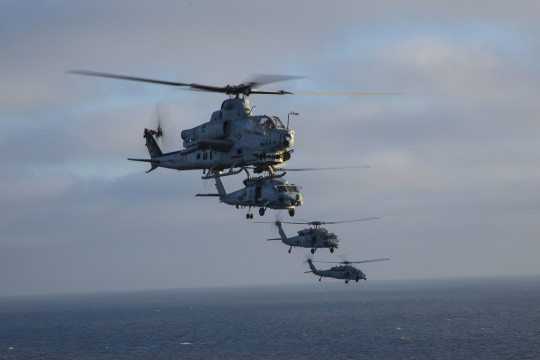
"Helo Formation"
Near to far:
USMC AH-1Z Viper - USN MH-60R Seahawk - two USN MH-60S Seahawks
#Airpower#Military#Helicopters#USMC#USN#Bell#Sikorsky#AH-1Z#Viper#MH-60#Seahawk#Aircraft#Marines#Navy
86 notes
·
View notes
Text
EXCLUSIVE from a #NordStreamSabotage whistleblower
Kim Dot Com was contacted by this whistleblower and was asked to publish this thread. He reviewed the radar evidence and it creates a compelling case of the US Govt blowing up the NordStream pipelines. There is no question in his mind that Joe Biden ordered this act of terrorism.
--------------------------------------------------
EXCLUSIVE from a #NordStreamSabotage whistleblower: I am writing to you as a concerned citizen of the world, wishing for a peaceful resolution to the conflict in Ukraine. My identity is not of importance. What matters is the sharing of my story so that the world can understand the truth about the Nord Stream Sabotage, thereby moving forward without lies or inaccuracies. As many of you may know, a series of clandestine bombings and subsequent underwater gas leaks occurred on the Nord Stream 1 and Nord Stream 2 natural gas pipelines on September 26, 2022. While there has been much speculation about the nature of this sabotage, I aim to provide additional details and facts that will give a clearer picture. Before the attacks on September 11, 2001, I started working with contractors at the Johns Hopkins Applied Physics Lab in Maryland. We were working on the Advanced Seal Delivery System (ASDS), a covert mini-submarine designed for the Navy Seals to carry out stealthy clandestine missions. This submarine is transported on the back of nuclear submarines and detaches to execute its missions. I was chosen to work on this project, and my role was to assist in the programming of the full-sized, temperature-controlled simulator for the submarine on which the Navy Seals would train. The simulator featured screens that displayed a 3D simulation of the ASDS undocking from a nuclear submarine, executing its mission, and then returning to dock. I spent countless hours in the simulator, ensuring everything functioned as specified. I piloted the simulator on simulated missions, just like the Navy Seal pilots would before their actual missions. Even in 2001, we had the ability to program a variety of scenarios, including the sabotaging of pipelines. Although I did not pilot a simulated mission specifically for the Nord Stream pipelines, I did simulate scenarios of covertly sabotaging pipelines. I can confirm that the United States has had this capability for decades, and the ASDS is in the US inventory, fully capable of executing the Nord Stream Sabotage. Publicly available radar evidence from http://flightradar24.com helps shine light on how the Nordstream sabotage was conducted. As exposed by Seymour Hersh, the explosives were planted during the Baltops 22 maritime exercises. Although speculation remains as to the exact method of explosives placement, I believe that the modern Advanced Seal Delivery System (ASDS) was utilized with Navy divers. This mirrors the way I would have conducted the mission in the simulator.
Once the explosives were planted, they would be triggered by sonobuoy. On September 25, at roughly 10:52 pm UTC, a US Navy Sikorsky MH-60R Seahawk appeared on radar in the Baltic Sea, east of Bornholm Island. Radar data indicates that this state-of-the-art helicopter, equipped with sonobuoy, had been hovering for an indeterminate length of time. Within clear range of the explosion, the US Navy Sikorsky is seen on radar loitering before, during, and after the explosion, until approximately 1:43 am UTC when it goes off radar in the Baltic, having hovered for over three hours in darkness. This helicopter was present at the scene of the explosion before, during, and after the event, equipped with sonobuoy capable of triggering the explosion.

Meanwhile, on September 25, at roughly 11:28 pm UTC, a US Navy Boeing P-8A Poseidon equipped with sonobuoy and with NO CALLSIGN appeared on radar east of the Faroe Islands. This Boeing P-8A Poseidon headed directly to the site of the first Nord Stream explosion near Bornholm Island, reaching an observational point at 1:08 am UTC on September 26, just over one hour after the first explosion at 12:03 am UTC. Important: The P-8A Poseidon took off >BEFORE< the first explosion and was heading to the coordinates were the explosion would occur.


At this juncture, the Poseidon had completed the first part of its mission, confirming the detonation of the explosives. It then flew over land near Miastko and rendezvoused with a US Air Force Boeing KC-135R Stratotanker for in-air refueling at 1:20 am UTC on September 26. The Poseidon circled with the Stratotanker until 2:28 am UTC, after which it was ready to complete the second part of its mission. It returned to the first explosion site for observation at 2:42 am UTC. It then made a tight loop at a low altitude, around 24,000 ft, directly above the explosion site for optimal observation. Afterward, it descended to a very low altitude of 7,275 ft in tight loops until it disappeared from radar at roughly 3:05 am UTC. At this point, the Poseidon likely dropped a sonobuoy to initiate the countdown for the second wave of explosions, which would occur approximately 14 hours later.




The same US Navy Boeing P-8A Poseidon with no callsign reappeared on radar at 6:22 am UTC on September 26, east of Bornholm Island. It flew to the site of the first explosion for a second look at 7:00 am UTC, then flew back and disappeared from radar at roughly 9:04 am UTC east of the Faroe Islands.


After the second wave of explosions at 5:03 pm UTC on September 26, the original US Navy Sikorsky MH-60R Seahawk reappeared on radar in the Baltic at roughly 6:42 pm UTC. It then hovered for over two hours until approximately 8:50 pm UTC, at which point it went off radar. During this time, it had an observational view of the aftermath of the second wave of explosions.

How the US blew up the Nordstream pipelines (Radar Evidence). I urge the public to review the publicly available radar data for themselves and witness the events as they unfolded, as it is easily verifiable. - ASDS Engineer
youtube.com/watch?v=iG71NGXr4vU
0 notes
Text
0 notes
Photo

[#Throwback] Ticonderoga-class guided missile cruiser, USS Lake Champlain (CG-57) sails through the Singapore Straits. Embarked MH-60R Seahawk multi-mission naval helicopter basks in the sun on deck. #MilitaryGeek #MilitaryEnthusiast #MilitaryAviation #ShipSpotting #ShipSpotter #USNavy #USN #USPacificFleet #7thFleet #CG57 #USSLakeChamplain #IngenuityDaringDiscipline #Sikorsky #MH60R #Seahawk #NavalHelicopter #Singapore #USA #Nikon #NikonD500 #Nikonsg #PlanesPatchesPeople (at Singapore / Singapura / 新加坡 / சிங்கப்பூர்) https://www.instagram.com/p/CiCI9CUB5lr/?igshid=NGJjMDIxMWI=
#throwback#militarygeek#militaryenthusiast#militaryaviation#shipspotting#shipspotter#usnavy#usn#uspacificfleet#7thfleet#cg57#usslakechamplain#ingenuitydaringdiscipline#sikorsky#mh60r#seahawk#navalhelicopter#singapore#usa#nikon#nikond500#nikonsg#planespatchespeople
0 notes